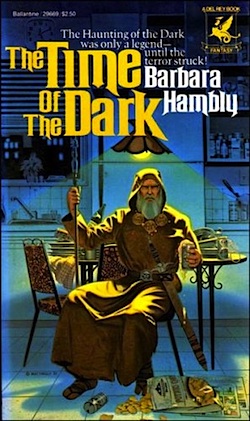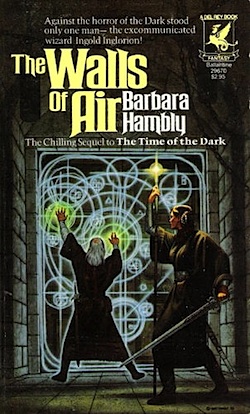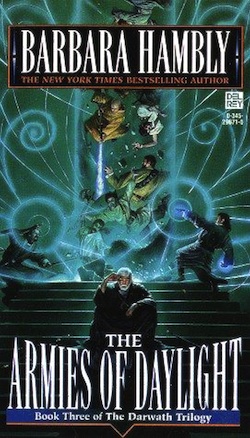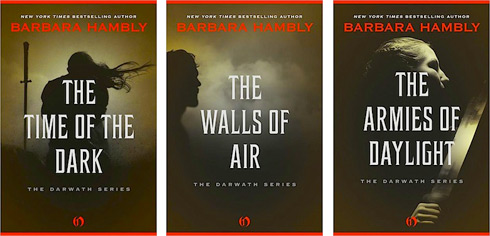This year has seen the release of much of Barbara Hambly’s out-of-print backlist in ebook format from Open Road Media. An exciting development for me: I’m young enough that some of these books were hard to find before I was even able to properly read. Yet, as an SFF reader, I’d heard nothing but praise for Hambly’s work since I became aware it existed, and her in-print historical mysteries made a convincing argument that I would really enjoy her fantasy—if only I could find it.
So you can imagine how welcome I found the news that Hambly had released ebook versions of the likes of Dragonsbane and The Ladies of Mandrigyn, amongst the greater part of her previously hard-to-find oeuvre. So welcome, in fact, that I simply have to tell you all about it.
I’m going to proceed in the general order of original publication. That means kicking off today with The Time of the Dark (1982) and its two sequels, The Walls of Air (1983) and The Armies of Daylight (1983), the three original books of Hambly’s Darwath series. Look out for future posts on The Silent Tower and the Sunwolf and Starhawk series—and perhaps more!
1982. I didn’t exist yet. Margaret Thatcher had been Britain’s Prime Minister for going on three years, the USSR was still a world power, and Ronald Reagan was President of the USA. (In case you’re wondering, I had to look that last one up.) Downbelow Station won the Hugo, Star Trek II: The Wrath of Khan showed in cinemas, and Del Rey sent The Time of the Dark out into the world for the very first time.

It’s a strong and atmospheric debut. In her dreams, graduate student Gil Patterson witnesses terror and panic in the night-time cities of another world. When the wizard Ingold Inglorion crosses the void between worlds to follow her home, it becomes clear her nightmares are not dreams at all. Ingold’s home is menaced by the Dark, beings all but forgotten until they returned in a welter of slaughter: the only hope for the Kingdom of Renwath lies in the ancestral memories of the House of Dare, whose last surviving member, Prince Tir, is a child too young to speak. Seeking refuge for this child, Ingold comes to Gil.
Things don’t go smoothly, and before long Gil and Ingold—joined by auto-mechanic Rudy Solis—are back in Ingold’s world, fighting against the extinction of the remnants of the realm. In the course of a long, grim flight to the last place of safety, the impenetrable Keep of Dare, Rudy becomes emotionally involved with the young widowed queen, Gil becomes a warrior, and all three are integrally involved in the politics of survival.
Hambly’s characteristic precision of phrase and turn of description is present here, even so early in her career. From the very beginning, the atmosphere is full of tension and dread. The tone belongs almost to horror: not the loud, garish horror of slasher films or serial killer thrillers, but the quiet, creeping, pervasive terror of a cold-sweat nightmare. The creatures of the Dark are both inimical and incomprehensible, and it’s their utter alienness—as well as their relentless progress—that renders them disturbing. (And I’m not ashamed to admit I got up to turn all the lights on while I was reading.) The fact that there can be no negotiation or compromise—not even communication—with the Dark makes them more like a natural catastrophe than antagonists. “What can I say of the Dark, Gil?” Ingold says:
“What can I say that you don’t know already? That they are the sharks of night? That they pull the flesh from the bones, or the blood from the flesh, or the soul and spirit from the living body and let it stumble mindlessly to an eventual death from starvation? That they ride the air in darkness, hunt in darkness, and that fire or light or even a good bright moon will keep them away? Would that tell you what they are?”
More human antagonisms play out against the backdrop of the catastrophe of the Dark, of course. Everyone in the Kingdom of Renwath wants to survive, but Lord Alwir, the queen’s brother, and the Church Bishop Govannin differ from Ingold Inglorion in their opinions both of the severity of the threat, and in how best survival is to be achieved. The politics and conflicts of personality established here continue in the next two instalments, in which the Church’s disapproval of things magical will come to play a greater role.
The Time of the Dark is part apocalypse story, and part — to borrow the coinage of, I believe, Jo Walton — portal fantasy. I’m a little surprised by how much more popular portal fantasy seems to have been in the eighties than it is today: it might merely be confirmation bias at work, but I can think of at least three other eighties-vintage portal fantasies (including Guy Gavriel Kay’s Fionavar Tapestry), while I’m hard-pressed to name more than one from the last five years. In the case of the Darwath series, the juxtaposition of worlds and worldviews works very well. Gil and Rudy have unique perspectives on the Kingdom of Renwath and the Rising of the Dark, and in The Walls of Air and The Armies of Daylight these come even more to the fore.

The Walls of Air, now that I’ve read it a second time, strikes me strongly as a book about learning, and about apprenticeship. The survivors of The Time of the Dark‘s desperate flight are holed up in the Keep of Dare. Outside, at night, the Dark wait. Inside, politics and claustrophobia form their own toxic atmosphere. Food is short. Refugees are arriving at the gates. In an attempt to find other wizards to help against the Dark, Ingold takes Rudy on a dangerous cross-country journey to the citadel of Quo, home of wizardry and learning. In the Keep, Gil and Queen Minalde must navigate the politics of subsistence and Lord Alwir’s determination to form an alliance with the armies of the southern power of Alketch in order to invade the Dark’s underground nests.
The journey to Quo is also Rudy’s journey of introduction into the disciplines of wizardry. Hambly’s wizardry is very much a combination of vocation and talent: the desire to know for the sake of knowledge, a fascinating combination of a perpetual scientific curiosity and vast—if occasionally odd—understanding. This sense of vocation is common to wizards across all Hambly’s early work. One might almost say it’s their defining attribute, and I’ll have more to say about it when I come to talk about the Silent Tower series.
In The Walls of Air, under Ingold’s unbending tutelage, Rudy grows into his identity as a wizard. He grows, too, in his understanding of the world he’s adopted as his own. In the wake of a terrible confrontation at Quo, a Rudy both more confident and more aware of his own limits emerges.
One of the most interesting things about The Walls of Air is how both Rudy’s and Gil’s previous lives inform their relationships to the new world in which they find themselves. Their experiences change them, but Gil is still a student of history, and the information she painstakingly collects from the few records which exist of the last time the Dark rose adds to the story’s tension as Ingold and Rudy approach Quo.

The Armies of Daylight provides the conclusion to the trilogy. Alwir will have his way: the Keep of Dare and its allies will mount an invasion of the Nests of the Dark. But how successfully? For Gil’s analysis of history suggests that perhaps, the last time they rose, no human agency caused the Dark to eventually retreat again. Meanwhile, tensions continue to rise between Alwir and Bishop Govannin on the one hand, and Ingold, Rudy, and the wizards on the other, with Queen Minalde caught in the middle.
In terms of personal politics and what actually happens, it’s probably the most complex story of the three: there are betrayals and reversals and some really unexpected developments, including the return of a character long believed dead. The tense atmosphere of cold, tense, creeping dread lasts right up until the final confrontation.
Which I’m not going to spoiler, because if you haven’t read the books and you intend to, knowing what happens with regard to the Dark in advance might wreck the fun. It would’ve ruined it for me.
The three books together form a very well-constructed trilogy. I’m particularly impressed by the way in which The Walls of Air fails to suffer from Middle Book Syndrome: it’s as tense and nerve-wracking as the first and final volumes. These are damn good books. Why did they ever go out of print in the first place?
A final note on the ebooks themselves: They’re generally well-laid out, but a small number of typos caught my eye, and — I don’t know whether this was also true for original paper format—there are no section breaks within chapters, even at moments such as changes in point of view where one might expect them.
P.S.: The thought occurred to me, after I wrote this review, that one could read a homily on the perils of climate change denialism into The Armies of Daylight. Or maybe I’m just strange that way?
Liz Bourke needs a more exciting bio. When she finds one, she’ll let you know.











I am old enough to remember when these books first came out and I remember reading each book and waiting anxiously for the next one to be released. I also recently reread this series and forgot how much I enjoyed them when they first came out.
I do remember reading one book after another in 1986 or 1987 and the strong tension created by the dreaded Dark. I usually dislike very much what I consider a cheap trick of the portal between worlds, but my dislike died out very quickly once the portal was crossed. I have not re-read the books since then, as I gave them away to friends, but the strong impression made by them remains. In its entirety.
I love these books and pounced on them when they started appearing as ebooks. I couldn’t get everything since all of Hambly’s books appeared at once.
I agree with the characterization that these three have echoes of what I would call a horror sensibility.
Well, FWLIW, I’ve only read one book in the trilogy, The Walls of Air, and the impression I got was that Barbara Hambly was the first (and as far as I know, the only) Fantasy author to have used Alien as a source of imagery and as an inspiration.
If you remember Alien, this characterization:
is the characterization of the Alien. The rest of the details I think can be ascribed to HP Lovecraft and his tradition, though I don’t know how much of that tradition she is familiar with. But I am somewhat familiar with it, and I can even think of some stories I think she was equally familiar with.
Love these books, and Hambly. Not quite as much as the Silent Tower books partly, I think, because these are so much more intense. I read them in the 80s – late enough to get them all at once – and I had a crush on Ice Falcon so it was good to see the two later books appear, both of which are equally good, if not so intense.
I hadn’t thought about these books in a while, but seeing the titles on the front page brought back my fond memories of this series. I read them years ago when they came out and really enjoyed them.
I do also have a soft spot for the portal stories. Perhaps one’s response to these portal stories might in part be predicted by when you were exposed to many of them. I think there is a certain age/social condition at which the idea of a “portal” has a great appeal. I, for one, couldn’t get enough of The Chronicles of Thomas Covanent at a certain point.
They are damn good books, aren’t they?
@Aladdin_Sane:
I’m not sure I entirely agree about Alien. But I see where you’re coming from.
@chrisg:
I like portal fantasy quite a bit myself, even now. But some of it is excessively ridiculous: I came across a series by Joel Rosenberg which struck me that way. (Despite its entertainment value.)
I enjoyed the sense of brooding horror that was the dark, the excellent charatherisation and differing views of the Renwath Church.
::raises hand:: Also totally had a crush on the Icefalcon. Based characters on him and everything.
I love this trilogy so much, and I’ve posted about it in various other Hambly-tagged threads here at tor.com. Apparently I hadn’t posted about how I really love the way that Gil actually does science. It’s not just “hands wave, science is done! Shazam!” No, she tracks down ancient records, and pores over them, and confirms hypothesises, and presents her reseach and everything.
And Hambly obvious knew whereof she spoke. The book on mideval roads and bridges she mentions in the very beginning was one I’d checked out a week before I came across these for the first time.
I didn’t think the 4th and 5th books were as great, but Hambly wrote a novellette in the world last year, “Pretty Polly”, and it’s perfect. And you get a chance to give her $5 directly!
http://www.barbarahambly.com/?page_id=78
[…] Trilogy, Barbara Hambly — I’m not surprised if you’ve not heard of these books. Hambly wrote them early in her career, before some of her better-known stuff like her Star Wars and Star Trek tie-in novels, which are […]
I read first book of the trilogy while Soviet Union still was a thing, but at it last breath: “The Time of Dark” was translated in Russian in 1991, — and reading it quiet horror during unsuccessful (fortunately) military coup was, one could say, a double experience in horror. Reading about of destruction of Darwath, while listening over crackling short-wave radio reports about tank columns movement, I bet very few of Barbara Hambly American readers could score such experience… Yet, it was captivating enough to keep me out of thoughts what I am going to do when the tanks will, eventually, arrive. Fortunately, they never did — they coup failed about the time I finished reading the last page of yet unpublished translation. So, strangely, Hambly’s trilogy became in my mind strongly associated with sens of stoic optimism and quiet determination — and, indeed, these are the most prevalent undertones of her fantasy writing.
“The Walls of Air” were published next year and was a good parallel in my mind to followed economic collapse and political infighting of former Eastern Block. Unfortunately, in economical turmoils, failure of most publishing houses and hyperinflation the third book was never published (well, that unpublished translation, indeed, resurfaced on the net after 15 years), so I finished reading the trilogy only 10 years later when stumble upon it in a used book store in rural Wisconsin…
On the literary note, I was not familiar at the time with Key at all, so for me there were strong Tolkien allusions and, yes, “Aliens” on steroids…
Perhaps, the lack of “portal” motif in recent SciFi and fantasy could be explained partially by growing darkness of the overall tone and disillusionment in our society… We are increasingly filling confined to our everyday reality and lacking interest to imagining different.
For that I will address to the Hambly’s trilogy which, indeed, full of notion do not giving up before everything lost — and after that as well!